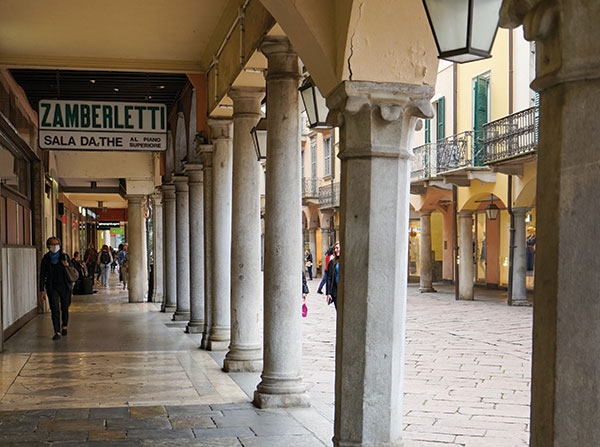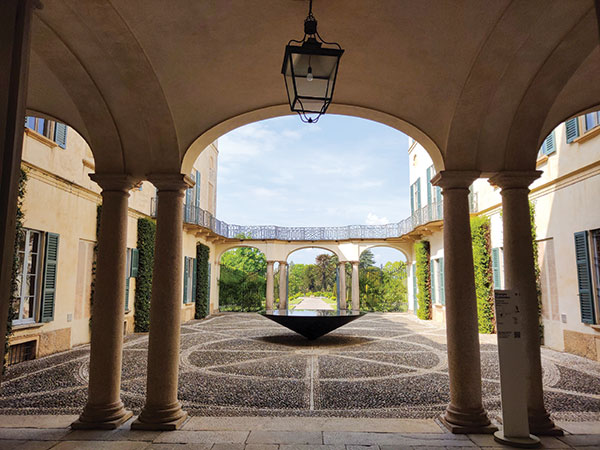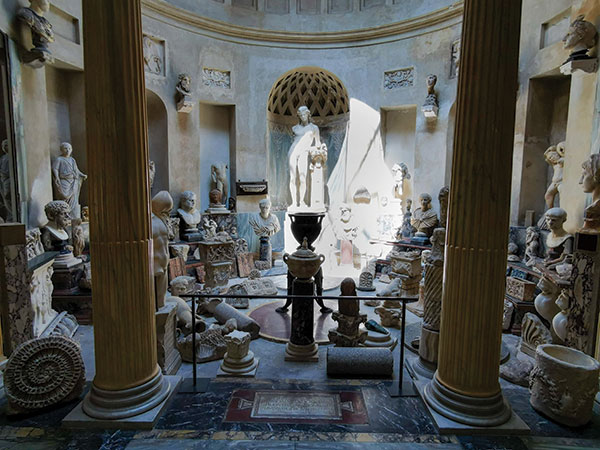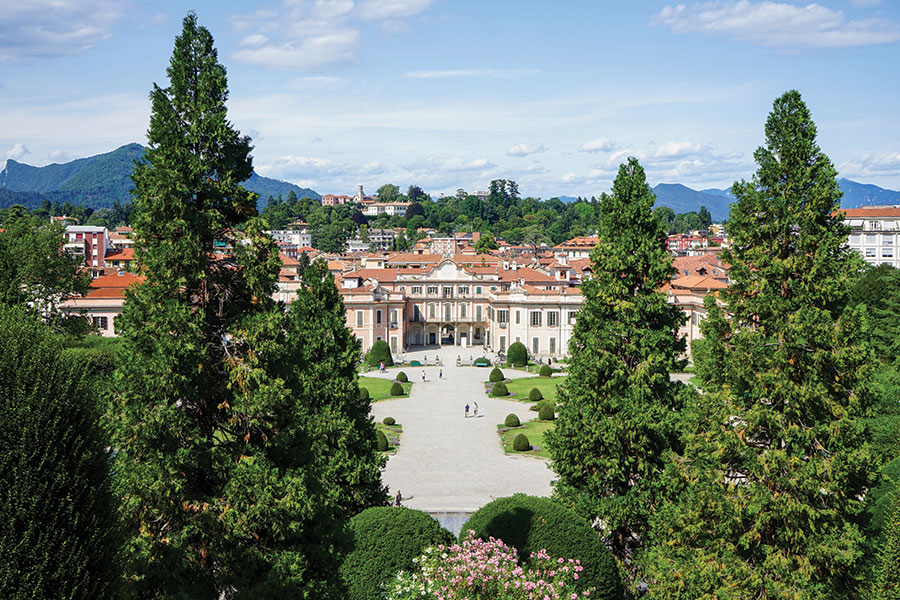Val Nicastro visits the “Garden City” north of Milan that is, among other things, home to a palace that one Italian poet described as “Little Versailles”
All images © Val Nicastro
With an enchanting old town, unmatched natural beauty and plenty to explore, Varese and its surroundings are one of Lombardy’s best-kept secrets.
Only one hour’s drive from Milan and a stone’s throw from Malpensa airport, this lovely town at the foot of the Alps sits quietly in the embrace of beautiful lakes, verdant valleys and monumental parks – a location that has earned it the nickname of “Garden City”.
During the mid-1800s, such a beautiful landscape prompted the development of the tourist industry in the area. Varese became the preferred holiday destination of the wealthy Milanese, who built grand mansions and parks that today represent an important part of the city’s diverse sightseeing agenda – one that offers visitors a wondrous 48-hour travel adventure.
“Little Versailles”
The first surprise awaits me at the Estense Palace, one of the city’s key symbols and the starting point of my adventure in Varese. As soon as I enter the gate from the busy Via Sacco, I hear myself whispering “wow” at the view that opens up in front of me.
A fantastic park in all its green glory sprawls over a hill, with trees and hedges trimmed with geometric precision framing views of the pink facade of the palace. No wonder the Italian poet Giacomo Leopardi once described it as “Little Versailles”.
The Duke of Modena Francesco III d’Este, who gained the lordship of Varese from the Empress Maria Theresa of Austria, commissioned its construction in the 18th century, taking inspiration from Schönbrunn Palace in Vienna.
Today the palace is the seat of the local administration and can only be visited when the offices are open. Do venture up the hill to Villa Mirabello, home of the Civic Archaeological Museum and a 19th-century Lebanese cedar tree.
Varese Old Town
Varese Old Town is an elegant treasure trove of sights. Corso Matteotti, the pedestrianised main street in pink porphyry, is flanked by colourful buildings and porticoes where locals lived and had their shops back in the 18th and 19th centuries, now replaced by upscale boutiques and cafés.
I stop at Pirola, just off the main street, to try the famous Apollo 11, the local aperitivo named after the historic moon landing, before continuing my exploration.
A scenic spot along Corso Matteotti is Piazza del Podestà, guarded by the old governmental palace and a bronze monument dedicated to the victorious battle fought in Varese in 1859 as part of the Second Italian War of Independence.
Right in front of it, the Arco Mera connects the old town to the religious district centred around Piazza San Vittore, where you can see the cathedral, the bell tower and the 13th-century Baptistery of San Giuseppe, the town’s most ancient monument.

From Piazzetta del Podestà you can also reach the Broletto, an arcaded 16th-century courtyard that looks like something out of a storybook. What I like about Varese is that there are plenty of places like this around town.
Continuing along Corso Matteotti, a huge wooden portal leads into the Cloister of Sant’Antonino, a 16th-century Benedictine convent turned into a residential oasis of peace and quiet.
When you get to Piazza Carducci, walk down Via Carlo Cattaneo to see another magical courtyard, home to the fabulous La Posteria restaurant.
Then go back to the square and indulge in some window shopping on Via San Martino della Battaglia.
Beautiful Mansions
From the old town, it’s an easy walk up the Biumo Hill to see Villa Panza, one of the many beautiful mansions that dot the Varese territory.
Its late owner, Giuseppe Panza, was an avid art collector and filled the Renaissance interiors with a superb collection of contemporary American art. The result is a juxtaposition of styles that’s as fascinating as it is unusual.
The jewel in the crown, though, is the fabulous Italian-style garden: 33,000 square metres of natural arcades, flowering shrubs and geometric patterns, with a lovely restaurant for relaxing meals.

Another period mansion worth checking out is Villa Toeplitz, a short drive from the town centre.
Built in 1901, it was purchased by the banker Giuseppe Toeplitz in 1914. With the help of his wife, Edvige, an avid traveller, he turned the villa’s gardens into one of Italy’s most beautiful parks.
The design takes inspiration from oriental gardens and boasts paths, statues, exotic species and attractive water features. Set in the grounds, Museo Castiglioni hosts a fascinating collection from expeditions the Castiglioni brothers made in Africa.
With another five-minute drive I’m at the Masnago Castle, a corner of medieval beauty immersed in another beautiful park with a hundred different varieties of trees and shrubs. The castle originally served as a fortress and then became a grand mansion.
Though the exterior looks unprepossessing, its rooms are filled with beautiful frescoes depicting scenes from court life in the 15th century. The castle houses the Civic Museum of Modern and Contemporary Art of Varese, which has works by Hayez, Guttuso and Pellizza.
Lakeside Cycling
For a bit of fresh air after all the sightseeing, I rent a bike at Lido Di Schiranna, a popular lakeside destination, and explore the trail around Lake Varese, a lovely basin of glacial origin close to the city centre.
The cycling trail is 28km in total but I do just a bit of it to enjoy the tranquillity of the place and some fine views. The path is well-marked and runs around the entire perimeter of the lake, passing through meadows, woods and picturesque villages.
One of the gems on Lake Varese is Isolino Virginia, an islet where people lived in houses built on stilts thousands of years ago and which is now part of the Prehistoric Pile Dwellings around the Alps UNESCO site. You can get there by boat from Biandronno, on the other side of the lake.
With more time, I would have also visited the ancient ice-houses at Cazzago Brabbia and Gavirate, another great lakeside spot with a curious pipe museum and the medieval cloister of Voltorre.
Sacred Mountain
My second day in Varese is mostly dedicated to the town’s holy mountain, the Sacro Monte di Varese. It is one of nine sacred mountains in Piedmont and Lombardy that UNESCO listed as a World Heritage Site for their spiritual meaning, artistic value and harmonious integration with the surrounding landscape.
I take bus line C and get off at the Prima Cappella (First Chapel) stop, where the trail starts. From there, a wide cobbled pathway departs, snaking through the mountainside for about two kilometres.
Along its route, 14 chapels filled with statues and frescoes depict biblical scenes relating to the life of Jesus. Though this may not be everyone’s cup of tea, the views alone are well worth the visit.
Santa Maria Del Monte
The cute village at the end of the trail, Santa Maria del Monte, is a real surprise to end your tour on.
There are flower-filled balconies lining cobblestoned alleys, some great viewpoints over the Alps and the lakes, and one of Italy’s most romantic hotels, the Burducan.
Santa Maria del Monte also boasts a number of interesting sites to explore, including a lovely sanctuary, the fifteenth chapel, with Baroque interiors and a crypt covered in ancient frescoes.
For art lovers, the Baroffio Museum has a very interesting collection of paintings, sculptures, and antique furniture.
Meanwhile, the Pogliaghi Museum boasts an incredible collection of 1,500 artworks and some 580 archaeological pieces gathered by the owner, architect Ludovico Pogliaghi throughout the years, including the life-size plaster of the main portal of the Duomo of Milan that he was commissioned to create.

The Tuscan Island of Lombardy
In the afternoon, I explore the surroundings of Varese and venture south to Castiglione Olona, intrigued by the nickname Italian poet Gabriele D’Annunzio gave to the place: the “Tuscan island of Lombardy”.
I must say he was quite right. Walking around this old village frozen in time reveals wonderful examples of Tuscan Renaissance art and makes you feel like you’ve stepped into a novel set in the 1600s.
It was the papal diplomate Cardinal Branda Castiglioni, an enlightened man of his time, who decided to revamp the ancient hometown of his family, based on the humanistic principles of the 15th century.
In order to realise his vision of an ideal citadel, he called the most important artists around. From among them, the Tuscan master Masolino da Panicale and his assistant Lorenzo di Pietro painted amazing frescoes that can still be admired in the Collegiate complex and the cardinal’s private palace. Just one more surprise from a destination filled with wonders.
Things to see and do in Varese
Sacro Monte di Varese |One of the nine UNESCO-listed sacred mountains of northern Italy, the Sacro Monte di Varese is a 2km devotional trail passing by 14 chapels and ending in the lovely village of Santa Maria del Monte. Watching the sunrise or sunset from up there is magical.
Estense Gardens | The Italian-style gardens of the summer palace of Francesco III d’Este are spectacular – one of the finest public parks in the whole of Italy. During the summer, they often serve as a beautiful backdrop for plays and operas.
Villa Panza | One of Varese’s most impressive villas, Villa Panza was built in the 18th century amidst a magnificent park with lovely views of the city. The villa is home to one of the largest collections of contemporary American art, amassed by its late owner Count Giuseppe Panza over fifty years.
Palia dei Castelli | Between June and July, the village of Castiglione Olona hosts an historical re-enactment that features parades with more than 250 people in period clothing, plus flag-throwing shows, a barrel race and fireworks displays.
Campo dei Fiori Observatory | On top of the Campo dei Fiori mountain (1,230m) there’s an important astronomical observatory founded by the astronomer Giovanni Schiaparelli in 1956. It offers guided visits by day and night (booking required) and has wonderful panoramic views on the lakes and the mountains.
Travelling to Varese
BY PLANE: The closest airport is Milano Malpensa, which is only a 30-minute drive away, while Bergamo Orio al Serio airport is about one hour away.
BY TRAIN: Trenord and Trenitalia trains connect Varese with Milan in about one hour; there are also frequent connections with other major spots in northern Italy, such as Como.
BY CAR: Varese is well connected to Milan via the A8 motorway “Autostrada dei Laghi”.
Discover more travel blogs in our archive
Words and images by Val Nicastro

